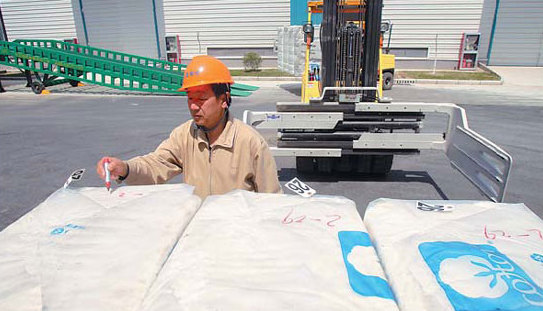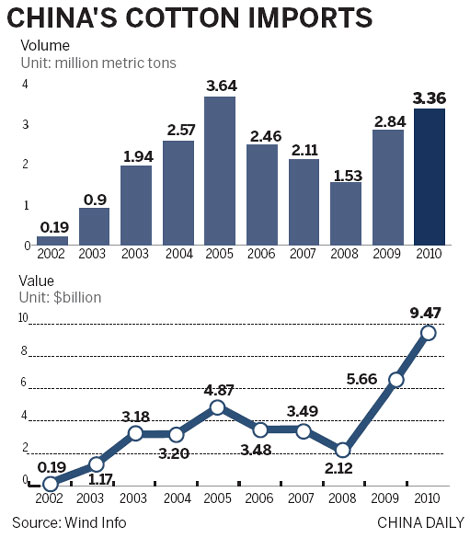
Cotton Council International, the export promotion unit of the National Cotton Council of America, said it remains "cautious" about making predictions concerning Chinese demand for US cotton in the coming year.
China's textile industry is struggling amid the current high price of domestic cotton and weak demand.
|
 |
|
A worker inspects cotton imports at a cotton reserve site in Nantong, Jiangsu province. [Photo/China Daily] |
"China has lost some competitiveness as a garment exporter," said Karin Malmstrom, CCI China director.
She said the high price of domestic cotton and an increase in labor costs have pressed a number of Chinese textile companies to scale back their production or move their production bases to neighboring countries in Southeast Asia, such as Vietnam.
The high price is largely a result of China's national reserve system, which sets a minimum price on cotton bought from farmers.
That system helped shore up the domestic price of cotton even as it became much cheaper in the international market, giving rise to a price discrepancy that was, at one point, as large as 50 percent between the two markets, according to CCI.
Chinese spinning mills, as a result, turned to importing yarn, which was also less expensive in the global market and, unlike cotton, was free of constraints from import tariff quotas.
"We have seen a record amount of yarn imports to China this year," Malmstrom said.
During the first nine months of the year, the amount of cotton yarn China imported increased by 74.4 percent from last year to 1.1 million metric tons, according to the General Administration of Customs.
"To encourage garment exports, the government should release additional cotton import quotas for mills," said Ma Wenfeng, a senior analyst at Beijing Orient Agribusiness Consultant Ltd, one of the industry's largest specialist consultancies.
In the meantime, weak demand in the retail market, which has resulted from the sluggish economic recovery in the European Union and the United States, as well as China's economic slowdown, has aggravated the situation.
Zhang Hongxia, chairman of Weiqiao Textile Co, China's largest cotton-textile maker, said in an interview with Bloomberg that the economic slowdown in China and weak external demand will curtail the company's cotton consumption by as much as 11 percent, to 8 million tons this year, down from 9 million tons in 2011.
"Chinese mills' demand for US cotton during the first half of this year was not growing as rapid as before," Malmstrom said. "But over the last few months, we have seen healthier numbers in both the US and China."
If a mild recovery occurs in the retail market next year, that might help raise cotton prices, Malmstrom said. Even so, she said a lot depends on how China decides to use its largest-ever national cotton reserve, as well as the import quotas for next year.
The worst the government could do would be to release its reserves at a bad time. Such a misstep could drag down cotton prices across the world and drive farmers to plant less cotton and more of other crops, Malmstrom added.
Hit by a market slump, a number of Chinese textile companies have called for the national reserve system to be abolished.
But Chinese analysts and experts said they believe the reserve will help protect farmers from being hurt by price fluctuations, which have appeared regularly in recent years.
"The more of a reserve there is, the more the government will be able to maintain the price of cotton at a certain level and ensure farmers' incomes," Ma said.
zhousiyu@chinadaily.com.cn

 China takes solar dispute to WTO
China takes solar dispute to WTO Govt offers incentives to electric car buyers
Govt offers incentives to electric car buyers Domestic auto lineup looks overseas
Domestic auto lineup looks overseas Electric car industry in the slow lane
Electric car industry in the slow lane